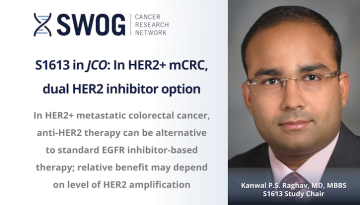ASH Splash: Improving Process Extends Lives
SWOG investigators had a more than reasonable showing at the American Society of Hematology annual meeting this year. At the conference, which wrapped up Tuesday, SWOG investigators made 18 presentations on our blood-based cancer research.
We actually had dozens of investigators and advocates on the ground in San Diego. The work of one of our teams – presented by Dr. John Pagel of Swedish Medical Center in Seattle – is worth special mention here. Pagel shared impressive results on a new approach to caring for patients with high-risk variants of acute myeloid leukemia (AML). The research team discovered that quickly identifying patients with high-risk AML, and speeding the process to find them a stem cell donor and performing the transplant earlier, can significantly improve survival.
The findings prove once again that the practice of medicine – not just medicines – can make a big difference for our patients.
Only 27 percent of AML patients survive five years after their diagnosis, and some have even worse odds. High-risk AML marked by certain genetic mutations is more chemo-resistant. As you know, even if high-risk AML initially responds to chemotherapy, relapse and death are all-too-common outcomes.
So the SWOG team wanted to quickly identify AML patients who were high-risk, and more quickly get them to transplant. They created a protocol that involved running DNA analysis on patients immediately upon diagnosis. The test signals high-risk - and likely extremely difficult to cure - variants of the disease with results returning in about a week. Working with the National Marrow Donor Program (NMDP), they also created a process to rapidly identify stem cell donors for these high-risk patients. All patients underwent a search for a match even as they were undergoing chemotherapy. This coordinated, proactive approach is different. The current system favors waiting until after chemotherapy fails to begin to seek an allogeneic transplant.
Did it work? Quite well. The transplant rate for high-risk patients increased from the 40 percent standard to 64 percent. And two-year survival for high-risk patients also increased significantly, from 22 percent to 45 percent for patients who received the transplant.
This work is potentially practice changing. We are proud of Dr. Pagel and his co-investigator, Dr. Guillermo Garcia-Manero of MD Anderson, and the entire team. Not to mention our other ASH presenters! To learn more about Pagel’s work, read the http://swog.org/Visitors/Download/Media/S1203Release.pdf) press release.
Other Recent Stories



